Lupus contains two stars with known planets but no formally named stars. The brightest star in the constellation is Alpha Lupi with an apparent magnitude of 2.30.
There are no Messier objects or meteor showers associated with Lupus constellation. However, it is home to several interesting stars and deep sky objects such as the globular clusters NGC 5824 and NGC 5986 and the supernova remnant SN 1006.
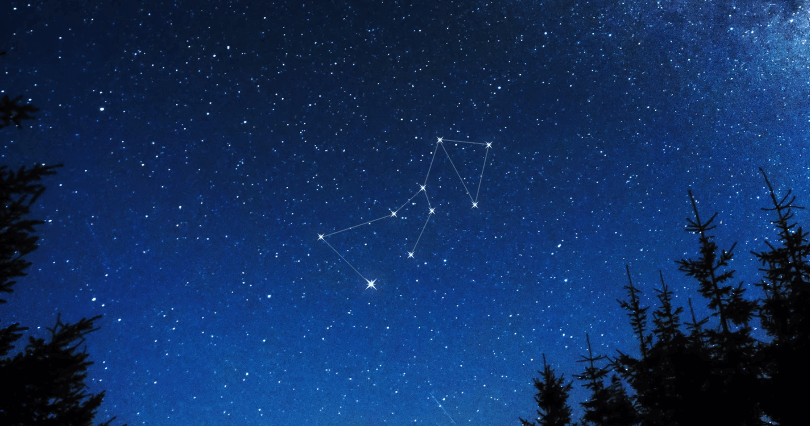
History and Mythology of the Lupus Constellation
Although Lupus is an old constellation, it is not associated with any Greek mythology. It was only the Latin translation of the name given to the constellation by Ptolemy in the Renaissance times that associated it with the wolf.
The stars that now form the constellation of Lupus used to form the constellation of Centaurus. In ancient times, the constellation was considered an asterism within Centaurus. In Greek times, the constellation was probably taken to represent a creature based on the Babylonian figure of the Mad Dog (UR.IDIM), which was a strange hybrid creature that combined the head and torso of a man with the legs and tail of a lion.
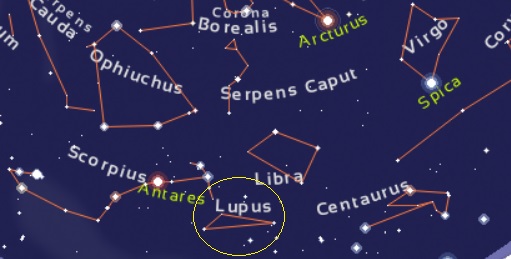
Location of the Lupus Constellation
Lupus is the 46th largest constellation and occupies an area of 334 square degrees. It is located in the third quadrant of the southern hemisphere (SQ3) and can be seen at latitudes between +35° and -90°.
Its right ascension is 15.3h and its declination is −45°. It is best seen at 9pm, during the month of June. The whole constellation is visible to observers south of latitude 34°N.
The neighboring constellations to Lupus are Centaurus, Circinus, Hydra, Libra, Norma and Scorpius. It belongs to the Hercules family of constellations, along with Aquila, Ara, Centaurus, Corona Australis, Corvus, Crater, Crux, Cygnus, Hercules, Hydra, Lyra, Ophiuchus, Sagitta, Scutum, Sextans, Serpens, Triangulum Australe and Vulpecula.
Notable Stars
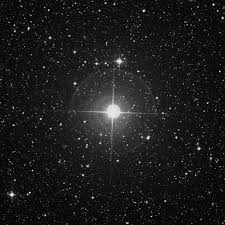
Alpha Lupi
Alpha Lupi is the brightest star in the constellation of Lupus and has an apparent magnitude of 2.30. It is a blue-white giant star with the stellar classification B1.5III, and is also classified as a Beta Cephei variable. While it is about 25,000 times more luminous than the Sun, it experiences periodic variations in luminosity, by about 0.03 over a period 0.29585 days, as a result of pulsations in the atmosphere.
Alpha Lupi is located 460 light years away from Earth and is ten times more massive than the Sun.
Beta Lupi
Beta Lupi is the second brightest star in the constellation of Lupus and has an apparent magnitude of 2.68. It is a blue-white giant with the stellar classification of B2 III. Like Alpha Lupi, it is classified as a Beta Cephei variable and experiences periodic variations in luminosity over a period of 0.232 days.
Beta Lupi is approximately 383 light years away from Earth, near the supernova remnant SN 1006, and can easily be seen without binoculars. It is also thought to be around 25 million years old and has a mass that is 8.8 times that of the Sun.
Gamma Lupi
Gamma Lupi is the third brightest star in the constellation of Lupus and has an apparent magnitude of 2.77. It is a blue-white subgiant that belongs to the stellar class B2 IV. It is a close binary system where the primary component is a spectroscopic binary star. It has an orbital period of 2.8081 days. Gamma Lupi is located approximately 420 light years away from the Solar System.
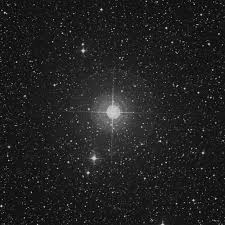
Delta Lupi
Delta Lupi is a blue-white subgiant with the stellar classification B1.5 IV and an apparent magnitude of 3.22. It is a Beta Cephei variable with a period of 0.1655 days.
The star is located around 900 light years away from the Sun and is around 15 million years old. It has a mass that is 12 times that of the Sun and a radius that is 6.1 times that of the Sun. It is also around 10,000 times more luminous than the Sun.
Epsilon Lupi
Epsilon Lupi has a visual magnitude of 3.41 and is located approximately 510 light years away from the Sun. It is a multiple star system that is a double-lined spectroscopic binary. The stars share a close orbit with a period of 4.55970 days. There is also a companion to the binary system that is separated by 26.5 arc seconds that may be orbiting the binary star with a period of 64 years.
Epsilon Lupi has the stellar classification B2 IV-V, while the individual stars are thought to have the classifications of B3 IV, B3 V and A5 V.
Zeta Lupi
Zeta Lupi is a yellow giant star that belongs to the stellar class G7III and has an apparent magnitude of 3.41. It is located around 116 light years away from the Sun.
Eta Lupi
Eta Lupi is a blue-white subgiant that belongs to the stellar class B2.5 IV and has an apparent magnitude of 3.41. It is located around 493 light years away from the Solar System.
Iota Lupi
Iota Lupi is a class B subgiant that has the stellar classification of B2.5IV and an apparent magnitude of 3.54. It is located around 352 light years away from Earth.
Phi Lupi
The designation of Phi Lupi is shared by two separate stars — Phi-1 Lupi and Phi-2 Lupi.
Phi-1 Lupi is an orange giant with the stellar classification K5 III and an apparent magnitude of 3.58. It is located around 326 light years away from Earth.
Phi-2 Lupi is a blue-white main sequence star with the stellar classification of B4V and an apparent magnitude of 4.52. It is located around 606 light years away from the Solar System.
Pi Lupi
Pi Lupi is a double system star that belongs to the spectral class B5. It has an apparent magnitude of 3.98 and is located approximately 497 light years away from the Sun.
Tau Lupi
The designation of Tau Lupi is shared by two separate stars — Tau-1 Lupi and Tau-2 Lupi.
Tau-1 Lupi is a blue-white subgiant star that belongs to the stellar class B2IV and has an apparent magnitude of 4.55. It is also a Beta Cephei variable star and is located around 1,035 light years away from us.
Tau-2 Lupi is a F7-class star with a visual magnitude of 4.36. It is located about 314 light years away from Earth.
Nu Lupi
The designation of Nu Lupi is also shared by two stars — Nu-1 Lupi and Nu-2 Lupi.
Nu-1 Lupi is a yellow-white star, halfway between the subgiant and giant evolutionary stage, with the stellar classification of F6III-IV and an apparent magnitude of 5.00. It is located around 111 light years away from the Solar System.
Nu-2 Lupi is a yellow main sequence star with which is very similar to the Sun but with a significantly lower metallicity. It has a mass that is 1.02 times that of the Sun and a radius that is 1.01 times that of the Sun. It is also 0.99 times as luminous as the Sun and has a rotational velocity of 2 km/s. In September 2011, three planets were discovered orbiting Nu-2 Lupi.
KT Lupi
KT Lupi, also known as 114 G. Lupi, is blue-white subgiant star with the stellar classification of B3IVp and an apparent magnitude of 4.54. It is a Be star, meaning that it is a class B star with strong hydrogen emission lines and distinctive forbidden neutral or low ionization emission lines in its spectrum. It is around 434 light years away from Earth.
GQ Lupi
GQ Lupi is an orange main sequence star which is classified as a T Tauri variable and has an apparent magnitude of 11.40. It has a mass that is 70 percent that of the Sun’s. It is located around 500 light years away from Earth and is less than 2 million years old. In 2005, a substellar object, GQ Lupi b, was discovered orbiting GQ Lupi.
RU Lupi
Ru Lupi is a yellow star with the stellar classification of G5V:e and an apparent magnitude of 10.519. It is also a T Tauri variable and is very young, between 2 and 3 million years old. RU Lupi has a mass that is 60 to 70 percent that of the Sun’s and a radius that is 1.6 times that of the Sun. It is located around 400 light years away from Earth.
RU Lupi exhibits random variations in brightness, including fluctuations in ultraviolet and X-ray emissions, and is surrounded by a circumstellar disk of dust. It also has an unconfirmed substellar companion in its orbit.
1 Lupi
1 Lupi is a yellow-white bright giant star with the stellar classification F1II and an apparent magnitude of 4.91. It is located around 1,140 light years away from us.
SN 1006
SN 1006 is a historic supernova, seen between April 30 and May 1 of the year 1006. It is believed to have been a Type Ia supernova and it reached a visual magnitude of -7.5, one of the brightest stellar events ever documented. It happened at a distance of 7,200 light years from Earth.
The supernova remnant was discovered in 1965 and is located near the star Beta Lupi, about 7000 light years from Earth.
Lupus-TR-3
Lupus-TR-3 is a dim orange main sequence star with the stellar classification of K1V and an apparent magnitude of 17.4. It is located around 8,950 light years away from Earth. In 2007, an exoplanet, Lupus-TR-3 b, was discovered in the star’s orbit. It has 0.81 times the mass of Jupiter and orbits the star with a period of 3.91405 days.
Deep Sky Objects
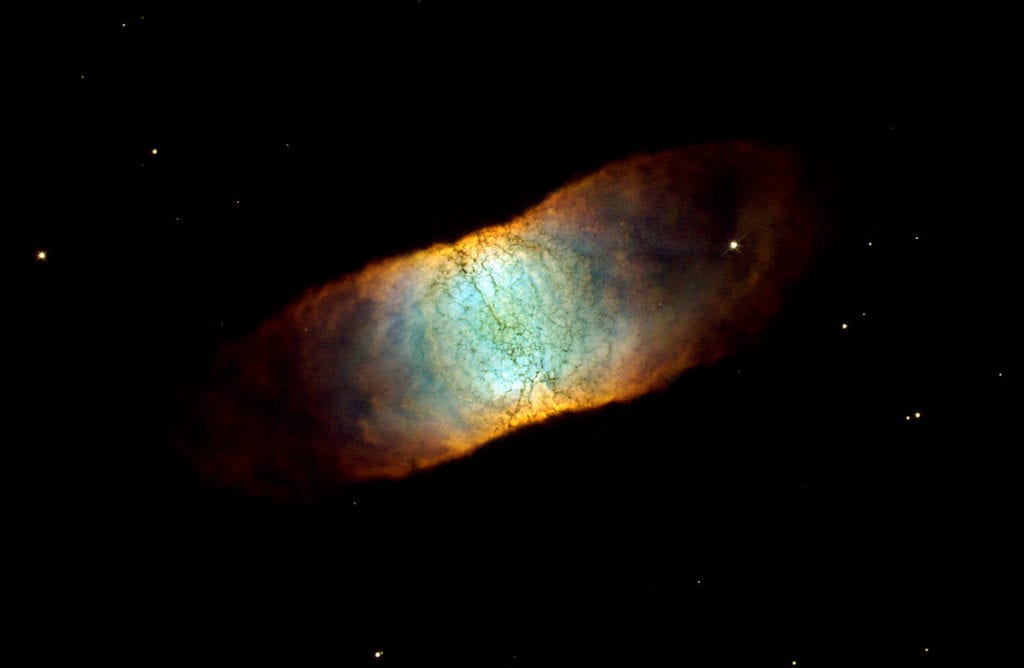
Retina Nebula
The Retina Nebula, also known as IC 4406, is a planetary nebula around 2,000 light years away from Earth and located near Lupus’ western border. It is a bipolar nebula, seen from the side when viewed from Earth. If viewed from the top, it would appear similar to the Ring Nebula in the constellation of Lyra.
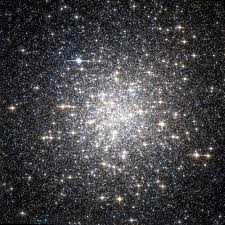
NGC 5986
NGC 5986 is a globular cluster that has an apparent magnitude of 7.52. It contains two very bright A-F class stars which are likely in their last stage of evolution.
NGC 5986 is located 33,900 light years away from Earth, around 2.5 degrees to the west-northwest of the star Eta Lupi.
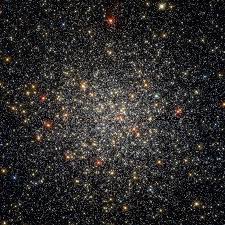
NGC 5927
NGC 5927 is a globular cluster that was discovered by James Dunlop in 1826. It has an apparent magnitude of 8.01 and is located around 24,800 light years away from Earth, near the border of constellation Norma in Lupus.
NGC 5882
NGC 5822
NGC 5822 is a large open cluster with an apparent magnitude of 10.28. It is located around 6,000 light years from Earth, 3 degrees to the southwest of the star Zeta Lupi.
NGC 5824
NGC 5824 is a globular cluster with an apparent magnitude of 9.09. It can be seen with a small, budget telescope.
It is located 104,400 light years away from the Solar System, near the western border of Lupus with Centaurus constellation.
NGC 5749
NGC 5749 is an open cluster with an apparent magnitude of 11.23. It was discovered by James Dunlop in 1826 and is around 8 arc minutes in diameter.
Extra Facts
- In Arab folk astronomy, Lupus, together with Centaurus were collectively called الشماريخ al-Shamareekh, meaning the dense branches of the date palm’s fruit.
- In Islamic Medieval astronomy, it was named السبع al-Sab’, which is a term used for any predatory wild beast.
- The three-letter abbreviation for the constellation, as adopted by the International Astronomical Union in 1922, is Lup.
Images:
- Some Images created with the NightVision app – https://www.nvastro.com/nvj.html
- Some Images created with the Stelvision Sky Map https://www.stelvision.com/en/sky-map/
- Lupus 1 – https://starregistration.net/constellations/lupus-constellation.html
- Alpha Lupi – https://theskylive.com/sky/stars/alpha-lupi-star
- Beta Lupi – https://theskylive.com/sky/stars/beta-lupi-star
- Gamma Lupi – https://theskylive.com/sky/stars/gamma-lupi-star
- Delta Lupi – https://theskylive.com/sky/stars/delta-lupi-star
- Retina Nebula – https://en.wikipedia.org/wiki/IC_4406
- NGC 5986 – https://en.wikipedia.org/wiki/NGC_5986
- NGC 5927 – https://en.wikipedia.org/wiki/NGC_5927